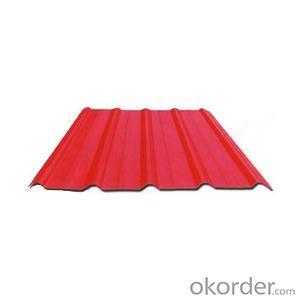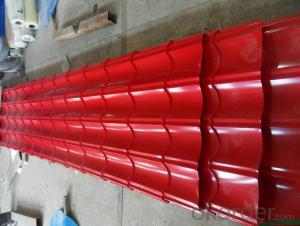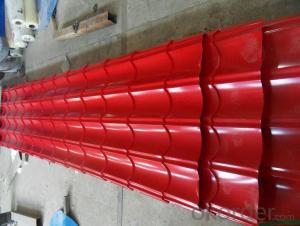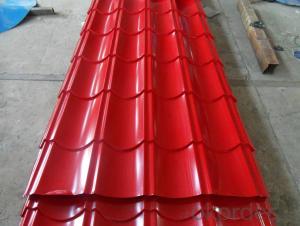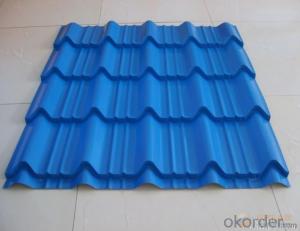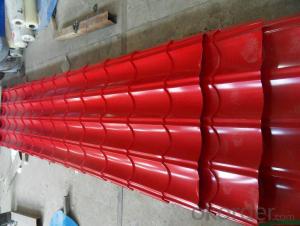Pre-Painted Galvanized/Aluzinc Steel Roof with Good Quality and Best Price
- Loading Port:
- Tianjin
- Payment Terms:
- TT OR LC
- Min Order Qty:
- 50 m.t.
- Supply Capability:
- 10000 m.t./month
OKorder Service Pledge
OKorder Financial Service
You Might Also Like
1. Pre-Painted Galvanized/Aluzinc Steel Roof Description:
With GI as base material, after pretreatment (degrease and chemical treatment ) and liquid dope with several layers of color, then after firing and cooling, finally the plate steel is called pre-painted galvanized (aluzinc) steel. Pre-painted galvanized roof is good capable of decoration, molding, corrosion resistance. It generally displays superior workability, durability and weather resistance.
2.Main Features of the Pre-Painted Galvanized/Aluzinc Steel Roof:
• Excellent process capability
• Smooth and flat surface
• Workability, durability
• Excellent heat resistance performance
• High strength
• Good formability
• Good visual effect
3.Pre-Painted Galvanized/Aluzinc Steel Roof Images
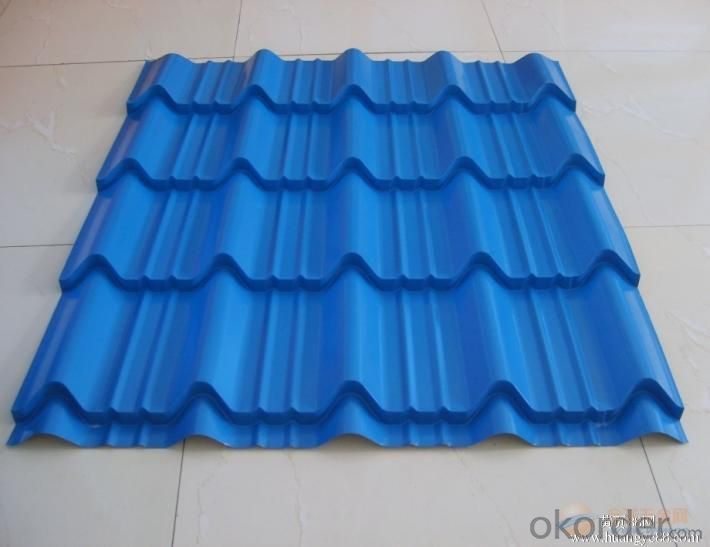
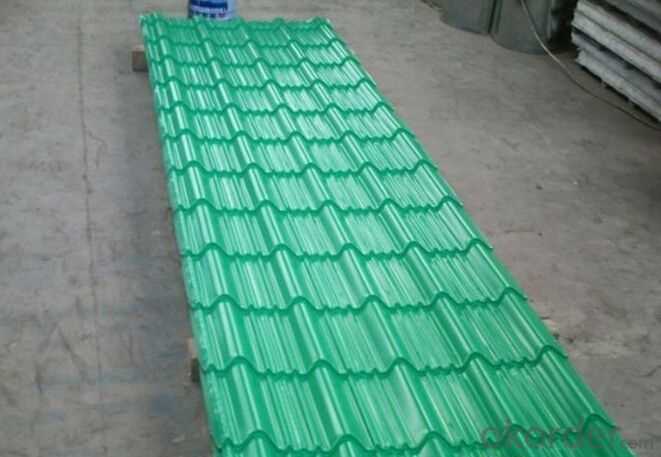
4.Pre-Painted Galvanized/Aluzinc Steel Roof Specification
Standard: AISI, ASTM, BS, DIN, GB, JIS
Grade: SGCC SGCH SGCD DX51D
Thickness: 0.13-3.0mm
Model Number: AISI, ASTM, BS, DIN, GB, JIS
Type: Steel Plate
Technique: Cold Rolled
Surface Treatment: Galvanized
Application: Container Plate
Special Use: High-strength Steel Plate
Width: 30-1500mm
Length: any length
color: RAL color
5.FAQ of Pre-Painted Galvanized/Aluzinc Steel Roof
What’s the brand of the paint?
We use the best brand of all of the word—AKZO.
What’s the wet and heat resistance of the roof?
More than 1000 hours.
- Q: What are the common coil surface finish standards?
- The common coil surface finish standards include mill finish, brushed finish, mirror finish, and embossed finish.
- Q: Steel is no doubt a better constructin material but it is only in practice in developed country.i would like that we should high lights the benifits and negatives of steel to make the steel more clear as a construction material.Hope some expert to address this topicMD
- Steel Structure considered as the most efficient and fast in completion of any project, specially the high rise buildings, also the logistics during construction is less complicated than the normal methods, Steel Structure has so many advantages vs the disadvantages, and highly recommended for commercial buildings
- Q: How do steel coil manufacturers handle product recalls?
- To ensure the safety and satisfaction of their customers, steel coil manufacturers have developed a systematic approach for handling product recalls. The following outlines the steps involved: 1. Identifying the issue: When a potential problem or defect arises in steel coils, manufacturers initiate the recall process. This can be a result of quality control failure, safety concerns, or non-compliance with industry standards. 2. Investigating and evaluating: The manufacturer investigates the root cause of the problem and evaluates its impact on customer safety and satisfaction. They analyze the affected batch or production run to determine the extent of the issue. 3. Notifying customers: Manufacturers promptly inform customers who have purchased the affected steel coils. They utilize various channels, such as direct mail, email, phone calls, or public announcements, to communicate the recall details. This includes specific information about the problem, potential risks, and instructions on how to proceed. 4. Retrieving and replacing: The manufacturer provides instructions on how customers can safely return or dispose of the recalled steel coils. They may offer options for product retrieval, such as direct pick-up or designated drop-off points. In some cases, manufacturers may provide replacement steel coils or reimburse customers for the affected products. 5. Communicating publicly: Steel coil manufacturers issue public statements and notifications to inform the wider market, distributors, and retailers about the recall. This ensures that all stakeholders are aware of the issue and can take appropriate actions. 6. Taking corrective measures: After retrieving the recalled steel coils, manufacturers implement corrective actions to rectify the issue. This may involve improving quality control processes, upgrading manufacturing equipment, or revising product specifications to prevent future recalls. 7. Providing customer support: Throughout the recall process, manufacturers offer customer support to address concerns, questions, or complaints. They establish dedicated hotlines, email addresses, or online portals to assist customers and guide them through the recall process. 8. Ensuring regulatory compliance: Steel coil manufacturers comply with relevant regulatory authorities and standards organizations during the recall process. They work closely with regulatory agencies to provide necessary information, documentation, and updates to meet legal requirements. In conclusion, steel coil manufacturers prioritize customer safety and satisfaction by following a well-defined process for handling product recalls. This includes identifying the issue, investigating, notifying customers, retrieving and replacing products, communicating publicly, implementing corrective actions, providing customer support, and ensuring regulatory compliance. Through these steps, manufacturers aim to rectify the issue, prevent harm, and maintain trust with their customers.
- Q: What are the different types of steel coil recoiling methods?
- There are several different types of steel coil recoiling methods, including oscillating recoiling, flying shear recoiling, and rotary recoiling.
- Q: What are the different types of steel coil slitting techniques?
- There are several types of steel coil slitting techniques, including rotary shear slitting, loop slitting, and oscillating slitting.
- Q: How are steel coils used in the production of shelving units?
- Steel coils are used in the production of shelving units by being cut and formed into various components, such as brackets and supports. These components are then assembled and welded together to create the frame and structure of the shelving unit. The steel coils provide strength and durability to the shelving units, ensuring they can withstand heavy loads and provide long-lasting storage solutions.
- Q: and what type of metal is steel?
- Iron and carbon is call mild steel, low carbon steel or high carbon steel depending on the percentage of carbon use , higher the carbon is used the tougher the steel is .but as far as I vaguely remember, in high carbon steel its only 3% of less carbon. Iron in its pure state is called wrought iron which is soft. Then there are Tool steel, High speed steel [drill bits and cutting tools are made]. Spring steel. [springs ] are made. Then we have alloy steel is another
- Q: What are the different methods of coil packaging for steel coils?
- There are several different methods of coil packaging for steel coils, each with its own advantages and suitability for specific applications. Some of the common methods include: 1. Strapping: This method involves using steel or plastic strapping to secure the coil and prevent it from unwinding or shifting during transportation. Strapping can be done manually or with the help of strapping machines, offering a cost-effective and reliable packaging solution. 2. Stretch wrapping: Stretch wrapping involves using a stretch film to tightly wrap the coil. The film is stretched and wrapped around the coil, providing protection against dust, moisture, and damage. This method is suitable for lightweight coils and offers good visibility of the product. 3. Steel banding: Steel banding is a robust and heavy-duty packaging method that involves using steel bands to secure the coil. This method provides high strength and durability, ensuring that the coil remains intact during transportation or storage. 4. Edge protectors: Edge protectors are used in conjunction with other packaging methods to safeguard the edges of the coil. These protectors are typically made of cardboard or plastic and provide additional support to prevent edge damage. 5. Wooden crates: For heavy or fragile steel coils, wooden crates are often used to provide maximum protection. The coils are placed inside the crate and secured with strapping or steel banding. Wooden crates offer excellent strength and stability and can be customized to fit specific coil dimensions. 6. Paper interleaving: This method involves inserting layers of paper or cardboard between individual wraps of the coil to prevent scratching or marking. Paper interleaving is commonly used when the coils are stacked together or when they have a high surface finish that needs to be protected. 7. Automated packaging systems: In larger-scale operations, automated packaging systems can be utilized. These systems are designed to handle and package coils using various methods, such as strapping, stretch wrapping, or steel banding. They offer increased efficiency and productivity while ensuring consistent and secure packaging. The choice of coil packaging method depends on factors such as the size and weight of the coil, transportation requirements, level of protection needed, and cost considerations. It is essential to select the appropriate packaging method to ensure the safe delivery of steel coils to their destination.
- Q: steel of beam has been rusted ,how can i repair it?
- The rust needs to be removed by what ever means works best for your situation.. Often a twisted wire wheel on a 4 1/2 angle grinder works quickly... a hand wire brush may work well for you, or just plain sandpaper and a LOT of elbow grease (hard work) will remove the rust. From there, a coat of primer paint made for steel. Any hardware store in your area would have such a primer, in quart cans or spray cans. Once that is dry (a good 24 hours for most formulations), you can spray or brush paint the beam most any color you wish.. I've had very good luck with acrylic enamel paints for such projects.. IF your steel is badly pitted, you should consider getting it inspected to insure it will still hold up or support what ever it was installed to do. If you want a smooth finish, once the rust removal is done, you can fill in the dips and pock marks with an auto body filler (Bondo is one brand name)... It comes in 2 parts (the main filler and a hardener) that are mixed well and used to fill in the holes and divits with a plastic spreader.. Once hard (in a few minutes with most brands of filler), sanding with sandpaper and a sanding block will smooth out the finish very nicely. From there, the same primer mentioned above and paint will finish up your project... Hope this helps some... Good Luck!
- Q: How do steel coil manufacturers minimize waste and maximize efficiency?
- Steel coil manufacturers can minimize waste and maximize efficiency through a combination of advanced technology, process optimization, and waste management practices. One way to achieve this is by using advanced automation and control systems in the production process. These systems can monitor and adjust various parameters such as temperature, pressure, and speed, ensuring that the manufacturing process operates at the optimal level. By closely monitoring and controlling these parameters, manufacturers can reduce the occurrence of defects and errors, which in turn minimizes waste. Another approach is to implement lean manufacturing principles. This involves eliminating any non-value-adding activities and streamlining the production process to reduce waste and increase efficiency. By carefully analyzing the entire production workflow, manufacturers can identify areas that can be improved, such as reducing setup times, eliminating bottlenecks, and optimizing material flow. This results in a more efficient and streamlined production process, minimizing waste and maximizing productivity. Furthermore, steel coil manufacturers can implement effective waste management practices. This includes proper handling and disposal of waste materials, as well as implementing recycling programs. By separating and recycling materials such as scrap metal, manufacturers can reduce the amount of waste generated and minimize the environmental impact of their operations. Additionally, manufacturers can explore partnerships with recycling companies to ensure that waste materials are properly managed and recycled. In summary, steel coil manufacturers can minimize waste and maximize efficiency by utilizing advanced technology, implementing lean manufacturing principles, and implementing effective waste management practices. By continuously striving for improvement and optimization in their processes, manufacturers can reduce waste, increase productivity, and ultimately achieve higher levels of efficiency.
Send your message to us
Pre-Painted Galvanized/Aluzinc Steel Roof with Good Quality and Best Price
- Loading Port:
- Tianjin
- Payment Terms:
- TT OR LC
- Min Order Qty:
- 50 m.t.
- Supply Capability:
- 10000 m.t./month
OKorder Service Pledge
OKorder Financial Service
Similar products
Hot products
Hot Searches
Related keywords
